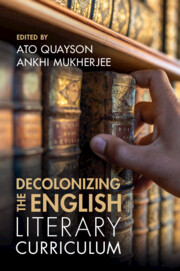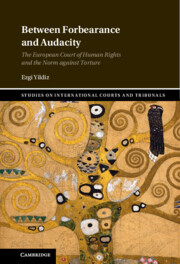Refine listing
Actions for selected content:
134859 results in Open Access
Comprehension and processing of the universal quantifier in children, adolescents and adults
-
- Journal:
- Journal of Child Language / Volume 52 / Issue 1 / January 2025
- Published online by Cambridge University Press:
- 03 November 2023, pp. 96-116
-
- Article
-
- You have access
- Open access
- HTML
- Export citation
Use of Open Access AI in teaching classical antiquity. A methodological proposal
-
- Journal:
- Journal of Classics Teaching / Volume 25 / Issue 49 / Spring 2024
- Published online by Cambridge University Press:
- 03 November 2023, pp. 17-21
-
- Article
-
- You have access
- Open access
- HTML
- Export citation

Decolonizing the English Literary Curriculum
-
- Published online:
- 02 November 2023
- Print publication:
- 09 November 2023
-
- Book
-
- You have access
- Open access
- Export citation

Between Forbearance and Audacity
- The European Court of Human Rights and the Norm against Torture
-
- Published online:
- 02 November 2023
- Print publication:
- 16 November 2023
-
- Book
-
- You have access
- Open access
- Export citation
Chapter 1 - Defining Caricature
- from Part I - Caricature Talk
-
- Book:
- Caricature and Realism in the Romantic Novel
- Published online:
- 19 October 2023
- Print publication:
- 02 November 2023, pp 3-27
-
- Chapter
-
- You have access
- Open access
- HTML
- Export citation
Index
-
- Book:
- Caricature and Realism in the Romantic Novel
- Published online:
- 19 October 2023
- Print publication:
- 02 November 2023, pp 255-259
-
- Chapter
-
- You have access
- Open access
- HTML
- Export citation
6 - Religion and Spirituality in Romantic Relationships
-
-
- Book:
- The Sociocultural Context of Romantic Relationships
- Published online:
- 19 October 2023
- Print publication:
- 02 November 2023, pp 90-114
-
- Chapter
-
- You have access
- Open access
- HTML
- Export citation
Afterword
-
- Book:
- Caricature and Realism in the Romantic Novel
- Published online:
- 19 October 2023
- Print publication:
- 02 November 2023, pp 204-206
-
- Chapter
-
- You have access
- Open access
- HTML
- Export citation
Abbreviations
-
- Book:
- Tokens and Social Life in Roman Imperial Italy
- Published online:
- 07 November 2023
- Print publication:
- 02 November 2023, pp xviii-xx
-
- Chapter
-
- You have access
- Open access
- HTML
- Export citation
2 - Managing Heterogeneity
-
- Book:
- Big Business and the Crisis of German Democracy
- Published online:
- 19 October 2023
- Print publication:
- 02 November 2023, pp 57-84
-
- Chapter
-
- You have access
- Open access
- HTML
- Export citation
Contents
-
- Book:
- Social Anarchism and the Rejection of Moral Tyranny
- Published online:
- 19 October 2023
- Print publication:
- 02 November 2023, pp v-vi
-
- Chapter
-
- You have access
- Open access
- HTML
- Export citation
Contents
-
- Book:
- Caricature and Realism in the Romantic Novel
- Published online:
- 19 October 2023
- Print publication:
- 02 November 2023, pp v-vi
-
- Chapter
-
- You have access
- Open access
- HTML
- Export citation
Chapter 7 - A State-Tolerant Anarchism
-
- Book:
- Social Anarchism and the Rejection of Moral Tyranny
- Published online:
- 19 October 2023
- Print publication:
- 02 November 2023, pp 203-223
-
- Chapter
-
- You have access
- Open access
- HTML
- Export citation
Figures
-
- Book:
- Tokens and Social Life in Roman Imperial Italy
- Published online:
- 07 November 2023
- Print publication:
- 02 November 2023, pp viii-xv
-
- Chapter
-
- You have access
- Open access
- HTML
- Export citation
3 - Redefining Lexical Semantics and Pragmatics
-
- Book:
- Linguistic Knowledge and Language Use
- Published online:
- 19 October 2023
- Print publication:
- 02 November 2023, pp 66-116
-
- Chapter
-
- You have access
- Open access
- HTML
- Export citation
Index
-
- Book:
- The Sociocultural Context of Romantic Relationships
- Published online:
- 19 October 2023
- Print publication:
- 02 November 2023, pp 273-275
-
- Chapter
-
- You have access
- Open access
- HTML
- Export citation
12 - Situating Latinx Immigrant Romantic Relationships in the Context of Illegality
-
-
- Book:
- The Sociocultural Context of Romantic Relationships
- Published online:
- 19 October 2023
- Print publication:
- 02 November 2023, pp 226-246
-
- Chapter
-
- You have access
- Open access
- HTML
- Export citation
Acknowledgements
-
- Book:
- Caricature and Realism in the Romantic Novel
- Published online:
- 19 October 2023
- Print publication:
- 02 November 2023, pp ix-x
-
- Chapter
-
- You have access
- Open access
- HTML
- Export citation
4 - Cult, Euergetism and the Imagery of Festivals
-
- Book:
- Tokens and Social Life in Roman Imperial Italy
- Published online:
- 07 November 2023
- Print publication:
- 02 November 2023, pp 127-169
-
- Chapter
-
- You have access
- Open access
- HTML
- Export citation
2 - Systemic Racism and Romantic Relationships
-
-
- Book:
- The Sociocultural Context of Romantic Relationships
- Published online:
- 19 October 2023
- Print publication:
- 02 November 2023, pp 7-28
-
- Chapter
-
- You have access
- Open access
- HTML
- Export citation
